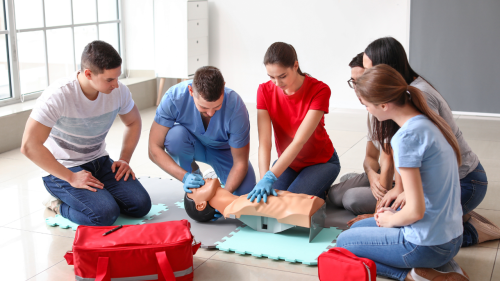EMT terms and paramedic terminology can be complex and confusing, especially if you are the loved one of someone who is receiving emergency medical care. Many paramedic terms are the same medical terminology used by nurses and doctors because paramedics are also highly trained healthcare professionals who perform complex lifesaving procedures on patients, often in extreme situations. Nobody wants to become a paramedic’s patient, but if you or a loved one does need paramedic help, there is some paramedic terminology you might want to know.
Here are the 10 paramedic terminology phrases everyone should understand:
1. A.L.S. Advanced Life Support
ALS is paramedic terminology for advanced life support, the advanced level of emergency care paramedics administer using invasive lifesaving procedures, including intravenous (IV) infusions, tracheal intubation, medication administration and electrocardiogram interpretation.
EMTs and medical first responders practice basic life support (BLS). Though EMTs can also perform lifesaving interventions, like defibrillation of cardiac arrest and epinephrine administration for anaphylaxis, EMTs receive less training and have a narrower scope of practice than paramedics. In many communities, BLS and ALS co-respondes to 911 emergencies and provides the most appropriate level of care after assessing the patient.
2. Anaphylactic shock
Anaphylactic shock is a collapse of the circulatory system function and a decrease in blood pressure from a severe allergic reaction. Anaphylaxis is a life-threatening condition that can result in death if not treated immediately with epinephrine, which can be delivered by laypeople and EMTs with an auto-injector, while paramedics can administer the medication by intramuscular injection.
Anaphylaxis can be caused by an allergic reaction to medications, bee stings, other insect bites and certain foods.
| Read how a flight paramedic survived an in-flight case of anaphlaxis.
3. Atrial tachycardia
Atrial tachycardia is an uncontrolled rapid heartbeat in the atria of the heart. This condition sounds scary, but it’s usually not life-threatening. It can however cause blood clots which can cause a stroke, which is life-threatening.
4. Cardiopulmonary resuscitation (CPR)
Most people know this term, but for the uninitiated, CPR refers to a life-saving procedure used when the heart has stopped beating and the patient has stopped breathing. It employs hand pressure on the chest to circulate blood to the patient’s heart and brain. Lay people are encouraged to perform hands-only CPR, use an AED as soon as it is available and call 911.
EMTs and paramedics will ventilate the patient with a bag-valve mask to deliver oxygen to the lungs, which chest compressions circulate to the heart, lungs and other tissue.
Anyone can learn how to perform hands-only CPR or receive just-in-time CPR instruction from a 911 dispatcher.
5. Cardiac arrest
Cardiac arrest is the sudden temporary or permanent cessation of the heart function. Simply put, the hear stops beating. Cardiac arrest needs to be treated rapidly with chest compressions and the application of an Automatic External Defibrillator. Call 911 as soon as possible and follow the 911 dispatcher’s instructions to care for the patient until EMTs or paramedics arrive.
6. Collapsed lung
A collapsed lung can occur as the result of a chest injury such as impact to the chest in a car accident or penetrating trauma from a knife puncture or gunshot. It can also be caused by lung disease.
7. Supraventricular tachycardia
Supraventricular tachycardia (SVTO) is another life-threatening heart condition. SVT is a synchronized rapid contraction of the heart ventricles, decreasing cardiac function and will cause death if it isn’t treated and corrected. The patient may report feeling like their heart is racing, having palpitations or feeling out of breath. The patient may also feel weak or anxious. Call 911, continuously monitor the patient until EMS arrives, have an AED nearby if one is available and know that you may need to deliver hands-only CPR with continuous chest compressions.
8. Triage
Triage means to sort and prioritize. This paramedic term involves the prioritizing of medical response according to the severity of the patient’s condition or injury. For example, dispatch might code a 911 call as Level 1, meaning the patient is critical and urgent, lights and sirens ambulance response. A Level 3 call is for patients who are not experiencing a life-threatening emergency and an ambulance response is not urgent.
Triage is also used during mass casualty incidents to identify the most critical patients, less critical patients and non-critical patients. Patients are sorted into triage categories, like red, yellow, and green. Red patients have life-threatening conditions and are prioritized for life-saving treatments and immediate transport to a hospital.
- 8 individual IFAKs each contain the essential tools to address severe bleeding
- Instruction card for quick and easy component identification
- QuikLitters are also included
9. Ventricular fibrillation
Ventricular fibrillation (V-fib) is uncontrolled spasm of the heart muscle with no cardiac output. V-fib results in rapid death if not corrected immediately. An AED or manual defibrillator is used to correct this condition through the delivery of an electric shock, allowing the heart to return to a normal rhythm, if successful.
10. Ventricular tachycardia
Ventricular tachycardia (V-tach) is another type of uncontrolled rapid heartbeat that is produced in the ventricular section of the heart. V-tach reduces cardiac function due to a decrease in ventricle filling with blood. V-tach is potentially life-threatening if it progresses to ventricular fibrillation or pulseless V-tach. A patient in pulseless V-tach has a heart that still has an electrical conduction signal, but blood is not being pumped mechanically out of the heart.
By knowing the paramedic terminology commonly used in emergencies, you can better understand the procedures they use in treating patients.
Paramedic terminology questions
Is there a term you’d like to learn or see added to this article? Email your question to an EMS1 paramedic or EMT educator.
References:
- National Registry of Emergency Medical Technicians
- NAEMT
- How to Become a Paramedic - About.com
- Emergency Care NY
- MedLine Plus
- U.S. Bureau of Labor Statistics
- AB Technical Community College
This article, originally published on June 06, 2011, has been updated.










